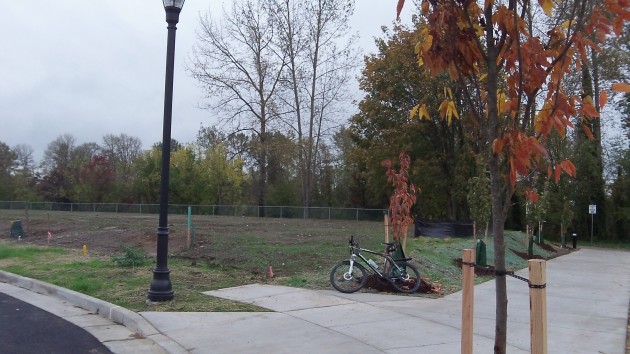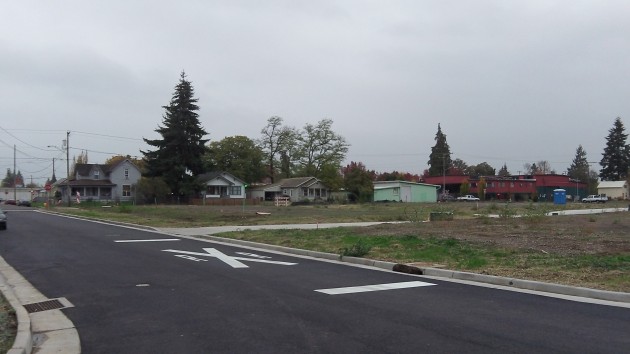Edgewater Village is a planned residential neighborhood that everyone hopes will rejuvenate Albany’s riverfront on the Willamette. The hope is there, along with new sewer lines and new streets, but the first house has yet to be started. The public has an interest because CARA, the city’s urban renewal program, has spent $2.4 million on this project, the plans for which have changed several times over about the last seven years.
In February, when a contractor started putting in utilities and streets on part of the 6-acre site between Water Avenue and the river, the city expected construction of the first five houses to start in March and be finished in September. But in May, the CARA board modified its contract with Edgewater Village LLC and extended its deadines.
Developer George Diamond, of Lake Oswego, at the time expected to break ground on the first house in September. But it didn’t happen that month, or in October. Last week, urban renewal manager Kate Porsche passed along an explanation from Rich Catlin, chairman of the CARA board who works on the project in his private employment as a planning consultant: While the street work is complete and being checked by the city staff, there’s database work to be finished by the county assessor’s office in assigning tax lot numbers and creating tax accounts. When that is done and the information has been transferred to the city, Edgewater can then file for building permits. All this may take between four weeks and two months.
Porsche points out that the revised CARA contract with Edgewater now calls for the first five houses to be constructed by Aug. 30, 2015.
Eventually, the plans call for 60 houses on the site, between the Lafayette Street trestle and Main Street. Diamond told the CARA board in May that once 19 houses have been built, the state will require crossing protection on access to the development across the Water Avenue rail line before any more can be done.
When will the entire project be completed? Based on the timeline so far, predictions would be risky. But the CARA loan will be forgiven at the rate of $40,000 for every lot completed with a house. (hh)



Whoa there big fella! Mr Hering, just what do you suppose is the hurry to get moving? CARA has consistently shown a lazi-faire approach to the millions they have to spend. Forgiving $40K for each lot developed!!!!!! Where is the liine to sign up? There needs to be a sunset clause enacted on CARA to put an end to this tax money give away!…JE
There is a Sunset date for CARA and has been since the day it was formed.
Jim, The CARA Plan says project activities will continue until tax year 2026-2027, unless they exceed the $56,000,000 maximum indebtedness limit before then.
In other words, we have another 12-13 years of CARA spending to keep us entertained.
“…..passed along an explanation from Rich Catlin, chairman of the CARA board who works on the project in his private employment as a planning consultant..”
I’m certainly glad there’s no appearance of a conflict of interest here!
I noticed the same thing, Hasso. What’s the deal here? Something smells.
Noticed what? (hh)
James Carrick explained in an off-line comment that he is concerned about the appearance of a conflict of interest on the part of Rich Catlin, chairman of the CARA Advisory Board who also works on the CARA-supported Edgewater Village project as part of his employment with an Albany development firm. Carrick would like an explanation. Here it is: There may appear to be a conflict, but reality there is not. All the major CARA decisions on Edgewater were taken years before Catlin was appointed to the board. Whenever the project comes up before the board now, he recuses himself. If it was me, for appearance’s sake, I would not serve on the board of a public agency that has a contract for a project on which I also worked — or vice versa — but the reality is that the law on public positions and private gain is being observed. (hh)
Thank you.
Well at the current rate with no houses in seven years; with a plan for 60. If they get the first one up by the end of the year. Yeah I know, can’t happen. But if they did at that rate it would take 420 years, right? Now that’s job security for somebody, their kid, his, kid, her kid, his kid, her kid, …………. Gotta love managing OPM (other people’s money). Free spending with practically no responsibility.
Whatever critics may say about this project, let’s remember what was there before. It was an abandoned packing plant. Before it was abandoned, it was a place stinking of fish guts. Afterwards, it became even more of an eyesore. Then it burned and as a ruin — until the city stepped in and cleaned it up — it was a monument to urban neglect by absentee owners and a possible breeding ground for crime. CARA tried to get somebody interested in doing something with the property and eventually managed to do just that. It’s been a long slog, not yet finished, but without CARA the property likely would have remained a wasteland forever. Now at least there’s a reasonable chance that the acreage will become a nice neighborhood, with possible good side effects on nearby properties up and down the river. (hh)
“. . . without CARA the property likely would have remained a wasteland forever.” This is an unwise remark; there is always a price for anything, not necessarily in a monetary form. I have to wonder what barriers have been placed on the use of this property. I venture to guess they exist. Why would absentee owners neglect a valuable property otherwise?
The barriers no doubt include the site’s being sandwiched between the river and a rail line, making development very difficult given today’s concern about crossing safety and the expense of installing gates and lights. As for absentee owners and why they would neglect a valuable property, look around at all the abandoned industrial and commercial sites. “Forever” was poetic license for “longer than I care to wait for something good to happen.” (hh)
I wasn’t going to respond to this, but it’s been nagging at me. I think its disingenuous to talk about physical barriers when likely you know I meant no such thing. I was referring to barriers of a different sort, namely government/city rules and regulations around building, which are prodigious.
I had mentioned the track in relation to your comment that someone else likely would have developed the land. My point was that this would have been unlikely without the efforts of CARA. Whatever figurative barriers there may be in regulations and such, add to them those that arise from the location of the site behind those tracks. (hh)
Hasso,
The CARA Report says that over its life CARA will produce $58.8M of total tax increment receipts. Is there a metric showing progress to date?
And what is the expected tax increment receipt for the Edgewater project?
Thanks for asking. I’ll add it to my list of questions to which I will seek answers. (hh)
Thanks for asking. I’ll add it to my list of questions to which I will seek answers. (hh)